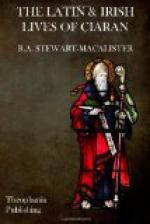LB and LC, which have many points of affinity, are in this incident almost word for word identical. They agree in saying that the men setting on the hound were spurred (uexati) by an evil spirit. The misplacing of this incident in LB is probably due to a transposition of the leaves of the exemplar from which it was copied.
VI. HOW CIARAN AND HIS INSTRUCTOR CONVERSED, THOUGH DISTANT FROM ONE ANOTHER (LA, VG)
Topography of the Story.—Assuming that Raith Cremthainn was somewhere near Rathcroghan, the distance between this and Fuerty would be about fourteen miles. There is no indication on the Ordnance map of any rock that can be identified with the cross-bearing stone on which Ciaran used to sit, though it clearly was a landmark well known to the author of LA. (Pace LA, Rathcroghan is north of Fuerty.)
Parallels.—The closest parallel is the story of Brigit, who heard a Mass that was being celebrated in Rome, though unable to hear a popular tumult close by (TT, 539). Something resembling the action of a wireless telephone is contemplated, the voices being inaudible to persons between the speakers. Thus the tales of saints with preternaturally loud voices are not quite in point. Colum Cille was heard to read his Psalms a mile and half away (LL, 828); Brenainn also was heard at a long distance (LL, 3419). The burlesque Vision of MacConglinne parodies such voices (ed. Meyer, pp. 12, 13).
VII. CIARAN AND THE FOX (VG)
Parallels.—There are endless tales of how saints pressed wild animals into their service; indeed the first monastic establishment of Ciaran’s elder namesake, Ciaran of Saigir, consisted of wild animals only: a boar, a badger, a wolf, and a stag (VSH, i, 219; Silua Gadelica, i, p. 1 ff.). Moling also kept a number of wild and tame animals round his monastery—among them a fox, which, as in the tale before us, attempted to eat a book (VSH, ii, 201); otherwise, however, the stories differ. Aed rescued a stag from hunters, and used its horns as a book-rest (VSH, ii, 296); Coemgen similarly rescued a boar (VSH, i, 244). So, in Wales, Saint Brynach caused stags to draw his carriage, and committed his cow to the charge of a wolf (Cambro-British Saints, pp. 10, 296). Saint Illtyd tamed a stag which he had rescued from hunters (ibid., pp. 164, 473).
Herding of Cattle.—There is abundant evidence from the Lives of the saints that the herding of the cattle while pasturing was an important duty of the children of the household. There was no little risk in this, owing to the prevalence of wolves.
Reading the Psalms.—The Psalms seem to have been the first subject of instruction given to young students; LB, 4, indicates that Ciaran’s lessons with Iustus did not go beyond the mere rudiments of learning. There is in the National Museum, Dublin, a tablet-book containing six leaves of wax-covered wood, on which are traced a number of the Psalms in the Vulgate version; this was most likely a lesson-book such as is here described. The story evidently grew up around an actual specimen, that bore injuries, explained as being the tooth-marks of the fox.




